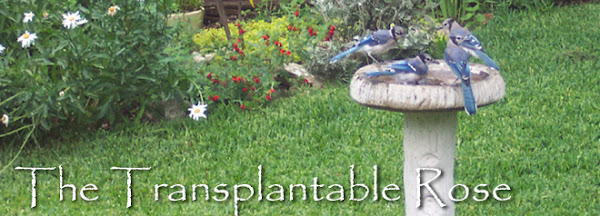
The edition I bought is part of the Modern Library Gardening Series, published in 2002, with an introduction to the series by Michael Pollan, and a forward by New York Times writer Verlyn Klinkenborg. This forward has biographical information about Karel Čapek, and a note that the pronunciation of Čapek is chop-uk, which I’m trying to remember. I found this quote via D.G. Jerz:
Čapek's obituary in Newsweek (January 2, 1939) said of the play R.U.R.: "Although he believed it the least interesting of all his works, it brought him greatest fame."
In 2007, the play R.U.R. is till famous and read by students of drama, but doesn’t it seem as if this little volume of garden philosophy has a wider readership? Perhaps Karel Čapek would be amused at that.
The Gardener’s Year was written in the Czech language and was first published in 1929, then in 1931 was printed in an English translation. 1929! That’s 78 years ago, but its descriptions of ridiculous, obsessed, yet still hopeful plant people sound like gardeners in the present, even though there have been changes in gardening over the decades. We still take the weather personally, forget what we’ve planted, buy too many plants, use the feasts of saints as days for planting crops, and struggle with garden technology – and we garden bloggers are all bonding with the author over our still unmanageable garden hoses.
Josef Čapek, the author’s brother, drew the whimsical illustrations, so full of wishful thinking, with winged gardeners suspended over the flowerbeds. I don’t think we’d love the book quite so much without the drawings! When Josef caught the Czech gardeners in action, the only women seem to be a couple of flappers mowing the lawn in dresses and heels. Was this really true at that time and place, I wonder? Did women not garden? Perhaps using men was a way to avoid indelicacy in the illustrations, so that Josef did not have to draw females astraddle rock gardens with rump in the air.
For me one of the most amazing and endearing aspects of Karel Čapek’s writing was the specific way he spoke about plants and soil. He doesn’t give you three names and then add ‘etc.’ His lists tumble on, his similes stretch for paragraphs and the descriptions are complete rather than suggestive, as when he speaks of of cactus:
The military references seem appropriate in hindsight, since Karel Čapek was only in his forties when he died, departing as the Nazis took over his land. For a heartbroken man so in love with soil, with earth, with humus, he may not have minded the leaving. As I read those passages on soil, it occurred to me that a few years after Karel Čapek’s death, another man was born with the same kind of passion for soil. And I kept imagining our John Dromgoole and Karel Čapek in conversation, spreading the word that you shouldn’t feed the plants, you should feed the soil!









"His lists tumble on"... what a wonderful way to describe Kapek's writing about soil and plants. And you always have a great message at the end of your book reviews, this one being "feed the soil".
ReplyDeleteThanks for participating in the Garden Bloggers' Book Club with your post!
I am so enjoying this book ... it was a delight to read your review. Those caricature drawings add much to the book as you say.
ReplyDeleteVery well written Annie. I've put this book on my to read list but it will take awhile yet before its turn comes up. So much to read, so little time (in between the gardening. ;-)).
ReplyDeleteAnnie, first I have to say I am so impressed that you know how to use diacritics in your posts! I still can't figure out how to get tags to show in the sidebar!
ReplyDeleteThis author sounds marvelous, the description of the cacti is priceless! I'm going to have to seek out this book!
Yataghans and abatis? I should have looked them up. I think I raced over the long lists to get to the next bit of wisdom.
ReplyDeleteYou know, I hadn't really noticed the treatment of women in the text - maybe I just take for granted that men are chefs and women are cooks, when described by men!
I'm also charmed by the winged gardener drawing - I included that picture in my post!
Annie, I'm glad you enjoyed this book. As you pointed out, it's been one of my favorites for a long time and I'm always pushing it on other gardeners.
ReplyDeleteI, too, love Capek's breathless lists...especially when he describes the "hundreds of prescriptions, principally contradicting each other" for potting soil. When he throws in humus "from the grave of a hanged virgin" he expresses the gardener's frustration on conflicting advice perfectly.
Yolanda, most of the essays are only a couple of pages long--perfect bathroom reading if you don't have any other time to tackle it.
If anyone can make me want to read a book, you can Annie. Thank you for this detailed and interesting book review.
ReplyDeleteIt's nice to see a long shot of your yard to give a little perspective. It's looking nice and green.
I haven't started the book yet! Can the month really be almost over already? Your review makes me want to get to it :-)
ReplyDeleteI always enjoy reading your reviews. You just have this way of making the books come alive for me.
The lists amazed me, too, Annie. I love the excess of them -- they're soaked in passion for his subject matter.
ReplyDeleteYour note about the encroaching war really brought that point home for me, too. I hadn't thought about the historical context...and that's really important.